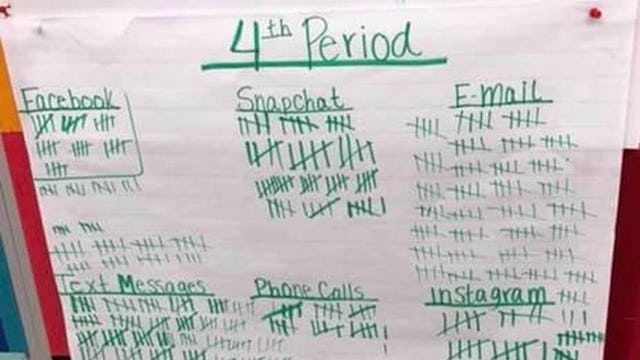Teacher's Experiment Shows Just How Much Phones Can Disrupt Learning

If this isn’t reason to keep cell phones out of classrooms, we don’t know what is
We all know just how much our phones have the ability to distract us. Adults generally realize that during times that require focus and attention, like at work, on a date, meeting up with friends or during family dinner, it’s best to leave cell phones put away. But what about kids? We all know what a struggle it can be to tear them away from their devices.
Still, the importance of keeping kids off their phones in the classroom has just been proven by one teacher’s viral experiment. According to a Facebook post making the rounds from Joe Becigneul, a school board trustee in Alberta, Canada, the teacher, Mary Garza, allowed her students to keep their phones on and with the volume turned up for a class period, just to teach them an important lesson.
“A teacher in the U.S. had her students turn their phones on loud, and every time they received a notification they went up and put a tally mark under the correct category. This was one class, one period. Every one of these tally marks is an interruption in a student’s education,” Becigneul wrote. “Cell phones can be toxic to a learning environment.”
According to the tally chart this teacher kept as her students’ phones continued to go off throughout just one class period, the kids collectively received well over a thousand notifications. During one class period. That means that if that class period was around an hour long, as they typically are, there was a phone going off every 2-3 seconds. It’s likely that the poor teacher did no actual lesson that day, because tallying all those notifications would have taken up the entire class period. But that’s not to say she didn’t teach an important lesson.
An experiment like this one makes a very visual case for why cell phones have no place in a learning environment. Even the most stubborn, phone-addicted kid in that class must have been able to see that this many notifications creates a classroom that’s distracted and not able to learn at its best.
While Garza’s experiment may not have been the most scientific, there is actual science that backs her up here. A 2015 study from Turkey’s Sakarya University followed 300 business students who were allowed to use their electronics during class. The researchers found that while some students used mobile devices to help them learn, like by looking up class subjects online or taking photos of notes or lecture slides, the vast majority of device use during class was not related to class. They also found that students who used their phones distracted other students who did not.
And a 2018 study published in Educational Psychology found that students who use their devices in class tend to get lower exam scores, but what’s even more striking is the effect they have on their peers — the study showed classmates who didn’t use their phones but were in a class with people who did also tended to score lower, suggesting that phone use in class distracts students who choose not to use phones and causes their education to suffer.
While mobile devices have brought a lot of knowledge and education to our worlds (scientific calculators in our pockets, anyone?) this evidence makes it pretty clear that they have no place in classrooms unless they’re completely shut off for purposes outside of education.
This article was originally published on